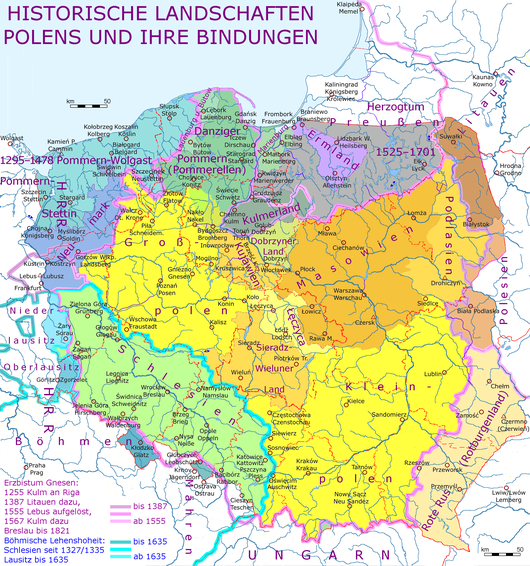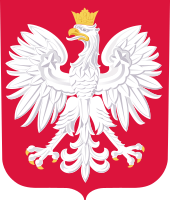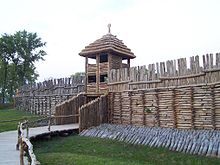History of Poland
The history of Poland covers the developments on the territory of the Republic of Poland and the historical Polish empires from prehistory to the present. The - unwritten - prehistory of Poland includes numerous Slavic tribes, castles, settlements and burial sites. An exact ethnic classification is uncertain. Today's ignorance about Poland's origins is a consequence of the scarcity of sources of the 10th century, which is called the "dark century" in historical research.
The - written - history of Poland begins in 963, when the Polish Duke Mieszko, Latin Misaca († 992), is mentioned as an able ruler by Widukind of Corvey in a Latin chronicle. Mieszko's voluntary acceptance of Christianity, by baptism in 966, led to the Christianization of Poland and protected the country from foreign proselytization. From his duchy, which is said to have included a tribe of Polans, emerged the Kingdom of Poland, recognized by the emperor and the pope and firmly established towards the end of the era of the Piasts (960-1386).
An important source for the foundation or recognition of a Polish state is the so-called Dagome-iudex-Regest, although it is not explicitly mentioned in it. It is assumed that the entry by a monk from the years 1086/1087 describes an act of donation by the Polish Duke Mieszko I to the Apostolic See from the year 991, by which Mieszko placed his city or country under the direct protection of the Pope. At the Krakow Academy, the document was referred to as Oda's donation.
The Polish Church developed independently of the Imperial Church and was in direct connection with the Roman Curia. The British historian Norman Davies called the official acceptance of Christianity "the most significant event in Polish history".
From the late Middle Ages until modern times, there was a dynastic connection with Lithuania through a personal union. From 1386 onwards, the union with the Grand Duchy of Lithuania under the Jagiellonian dynasty (1386-1572), which originated from there, brought about the rise to a major European power, whose territory stretched od morza do morza ("from sea to sea"), from the Baltic to the Black Sea.
From 1569 the union of Poland with Lithuania was consolidated in a common state. The noble republic, which existed from 1572 to 1795, manifested itself as an elective monarchy. In the 16th and 17th centuries, a high parliamentary culture with extensive nobility rights developed there. This led to a strong identification of the nobility, the magnate (high nobility) and the szlachta (landed nobility), with the country. The increasing structural grievances, caused by numerous wars with neighbouring states, civil wars and uprisings of the Ukrainian Cossacks, the unwillingness to reform on the part of those in positions of responsibility, in addition to egoism on the part of several elective kings and the nobility, led to the weakening of the Polish state. The diplomatic and military interference of the neighbouring states, the Empire of Russia, Prussia and the Habsburg Monarchy, finally caused the complete collapse of the state through three partitions in 1772, 1793 and 1795.
As a result, Poland disappeared from the maps of Europe as a sovereign state from 1795 to 1918. The partition period was marked by suppressed uprisings - in 1830, 1848 and 1863 - and very different developments in the three partition areas. Polish culture survived this period despite foreign oppression and its own statelessness.
After the state "rebirth" as the Second Republic after the end of the First World War in 1918, Polish history was characterized by a laborious state reorganization and several military conflicts with almost all neighboring states. The two dictators Hitler and Stalin agreed in the Additional Protocol to the German-Soviet Non-Aggression Pact concluded at the end of August 1939 to partition Poland once again. The invasion of Poland by the Wehrmacht, the beginning of World War II, and the Soviet invasion of eastern Poland were followed by years of German and Soviet occupation. Some six million Poles died in the Second World War. After the unconditional surrender of the Wehrmacht, Poland, which had been shifted westward, became a People's Republic and part of the Eastern Bloc under massive Soviet influence, and a satellite state (not always convenient for the Soviet Union). Revolutions in 1989 cleared the way for the Third Republic; it became a member of NATO in 1997 and of the European Union in 2004.

Aspects of territorial development

Dagome-iudex-Regest in the Vatican

Present coat of arms of the Republic of Poland
Prehistory and early history
→ Main article: Prehistory of Poland
Numerous prehistoric finds, the oldest from the Stone Age in the area of today's southern Poland, testify with fortifications, settlements and gravesites to various cultural epochs and the settlement of today's Polish territory. The assignment of the finds to a closed settlement area of the Poles is not clear. Migrations of various peoples through the territory of today's country caused a great ethnic diversity, in historical times one of the characteristics of the population of Poland. The British historian Norman Davies notes that prehistory is often interpreted in such a way that an "exclusive claim to ownership" of an area is derived from it in favour of only one ethnic group. This is what happened with the area between the Oder and Bug rivers; the "Autochthonous School" in Poland interprets the area as the "fixed and sole homeland of the Prasłowianie". The national Prussian historiography, on the other hand, made the area the original homeland of the Early Germanic tribes. In fact, the lengthy process that gave the Slavic, Polish-speaking element a predominant position within the overall population is obscure.
Taking into account the aforementioned limitations, it can be assumed that some Slavic tribes from the Dniester and Pripjet regions settled in the area between the Oder, Vistula and Baltic Sea between the 6th and 7th centuries. Their migration was triggered by the Hun storm at the beginning of the Germanic migration of peoples.

The settlement of Biskupin, a settlement of the Lusatian culture
Formation of the rule of the Polans
The tangible beginning of Polish history falls in the 10th century. Between 880 and 960 various West Slavic tribes between the Oder and Vistula rivers grew together to form a state. The most important of these tribes were the Opolans, the Slenzans, the Masovians, and the Wislans. Another tribe, the Polans (polanie, "field dwellers") is said to have established a permanent state, which emerged as a duchy in the late 10th century in the region around the cities of Posen and Gnesen. The fact that the ruling federation of the Polans, whose centre of settlement was an area around Gniezno, did not appear in the written sources in the 9th and 10th centuries was explained by older Polish historiography with the relative isolation of central Greater Poland. Without contact with the East Franks, Bohemia, Moravia, moreover away from the known trade routes, the Poles could have developed and consolidated here completely unnoticed by the outside world.
The emergence of their increasingly dense and coherent dominion territory took place through a planned conquest. The first traces of their violent actions can be found on the middle Warta and along the Obra, where at the beginning of the 10th century older small castles of various petty rulers, which had been established in the 8th-9th century, were systematically destroyed. The population there was resettled in the Gniezno Highlands, the possible ancestral territory of the Polans. For the Gniezno Highlands, neither a more intensive population nor a network of castles had been found by then. The ancestral territory was consolidated in the 920s and 950s by the expansion of the two castle villages of Giecz and Moraczewo. Furthermore, wooden and earthen ramparts and castle chains were built on its periphery. These planned extensions required large amounts of resources and a large number of workers. Archaeological evidence at this time indicates settlement geographic changes, in the course of which the western and southwestern regions of Wielkopolska were subjected to massive destruction and depopulation, while the Poznañ-Gniezno central area underwent internal colonization expansion and population increase.
The leaders of the Poles relied on an elite, tightly managed, powerful military following. From the 930s and 940s onwards, luxury goods of interregional exchange increasingly reached Wielkopolska. These were exchanged for people who were in demand especially on oriental and southern European slave markets. The actual subsistence of this ruling elite had to be paid for by the local population through taxes and services. Due to the still poorly developed agrarian society, this very quickly reached its limits. In order to secure the loyalty of his military followers, the duke had to supply and reward them regularly, for which his own territory and population were not sufficient. Thus, slaves could only be drawn to a small extent from the duke's own population. Therefore, raids and wars into foreign territories and the siphoning off of the resources there were an indispensable instrument for securing rule. This explains the rapidly increasing expansion of the Polans outside their own core territory.

Slavic tribes united during the reign of Duke Mieszko, including the Polans, Wislans, Silesians, Mazovians, Pomorans and Lendizians (Polish map).
Questions and Answers
Q: What is the History of Poland?
A: The History of Poland is the history of various territories during the past millennium.
Q: What was the status of the Polish-Lithuanian Commonwealth in the 16th century?
A: In the 16th century, the Polish-Lithuanian Commonwealth was the second largest state in Europe, after Russia.
Q: Was there always a separate Polish state?
A: No, at times there was no separate Polish state at all.
Q: When did Poland regain its independence?
A: Poland regained its independence in 1918, after more than a century of rule by nearby empires.
Q: Did the borders of Poland remain the same after the Second World War?
A: No, the borders of Poland shifted again after the Second World War.
Q: Why were the borders of Poland shifted after the Second World War?
A: The borders of Poland were shifted after the Second World War due to various geopolitical factors.
Q: What were some of the nearby empires that ruled Poland before its independence?
A: Some of the nearby empires that ruled Poland before its independence were Russia, Prussia, and Austria.
Search within the encyclopedia